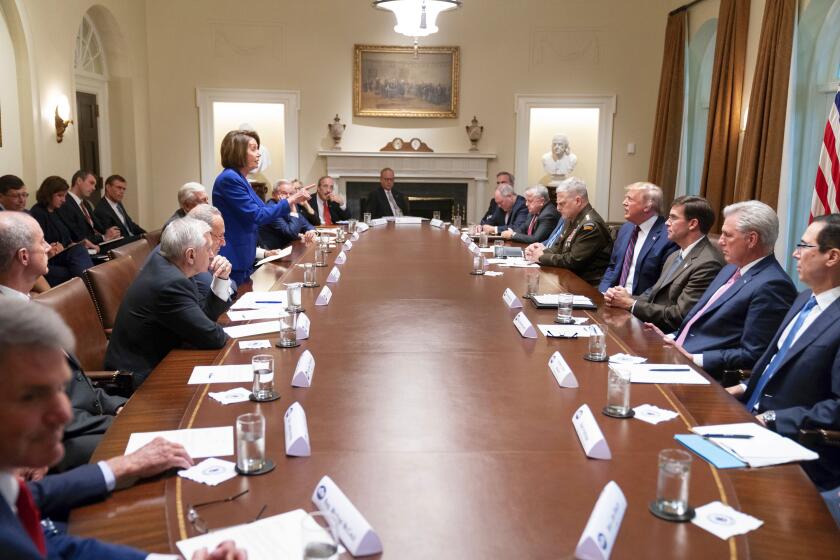The Tie-In King : Hyperion Books Rides the Crest of Disney’s Successes
In the decade since Michael D. Eisner took the helm, Walt Disney Co. has been a looky-loo on many deals, passing up opportunities to invest in established record companies, networks--even Mattel, the toy company.
Instead of buying, Disney frequently has launched new ventures from scratch. Two of the most notable attempts have been in recorded music and publishing. After six years, Hollywood Records can’t take credit for a single hit. But the Hyperion adult book publishing unit has turned profitable this year, thanks to tie-ins with Disney talent. Its best-selling book was penned by Tim Allen, star of Disney’s “Home Improvement” TV series and its “The Santa Clause” movie blockbuster.
Still, Disney has moved so cautiously that its publishing and recorded music units remain a minuscule blip on the radar screen of a company that posted more than $10 billion in 1994 revenue.
Is Eisner cheap, or is he wise?
On Wall Street, the Disney chairman has both critics and defenders.
John Tinker, an analyst at Furman Selz in New York, says: “I think it’s terrific to hear management not wanting to throw around shareholders’ money. I wish more managements were like that.”
But others fear that Disney may hobble its long-term growth if the company lacks the gumption to take bigger risks. Some analysts question whether internal growth alone can sustain Disney’s goal of 20% compound annual earnings growth and 20% annual return on stockholders’ equity.
Disney is a “non-entrepreneurial, non-risk-taking company past the point, I believe, of logic,” says Emanuel Gerard at Gerard Klauer Mattison & Co. in New York.
But Eisner insists on going slowly; his rule is “to crawl before we walk and walk until we learn to run.” He doesn’t rule out acquisitions, once Disney has grown more comfortable with its new businesses.
Here are the tales of two Disney start-ups.
*
The Walt Disney Co. has a reputation for being tight-fisted, but management is not stupid: Disney gave actor Tim Allen a Porsche last winter when he delivered the triple whammy of a box-office hit in “The Santa Clause,” the top-rated network television show “Home Improvement” and a best-selling book called “Don’t Stand Too Close to a Naked Man.”
No Disney division is more beholden to Allen than the Hyperion publishing unit. The Allen book has pushed the operation into the black for the first time since Disney entered the business in 1990. With more than 1.1 million copies sold, “Don’t Stand Too Close . . . ‘ is the best-selling book in Hyperion’s short history, and it proves the value of a tie-in to Disney’s formidable name, assets and marketing abilities.
More recently, Hyperion has enjoyed an unexpected best-seller in “The Beardstown Ladies’ Common-Sense Investment Guide,” which offers tips from 18 Illinois women who formed an investment club.
Disney won’t break out numbers for the operation, but sources say Hyperion revenue should approach $50 million this year. Of course, that sum is tiny compared to total 1994 company revenues exceeding $10 billion. Still, the division has received personal attention from Michael D. Eisner, Disney’s chairman and chief executive.
“I’ve been shocked at the level of attention that I get from Michael for what seems to be, in the scheme of Disney, a small business,” said John Skipper, vice president of the Disney Publishing Group, which includes children’s book publishing and magazines, as well as Hyperion.
*
Skipper attributes some of Eisner’s attentiveness to a personal interest in publishing.
“Michael reads. He likes books. He likes magazines,” Skipper said. “He likes the Hyperion business. He’s an intellectual; it’s an intellectual business. He is interested in it as a business, though. He . . . expects us to succeed.”
While the link between Disney and children’s book publishing is obvious, victory is less assured for Disney’s adult trade publishing--the industry term for hardcover fiction and nonfiction, and trade paperbacks.
Disney wrote a tough business plan when it launched both its adult and children’s Hyperion units from scratch, without the benefit of a “backlist” of titles. Backlists are as vital to publishing as film libraries are to motion picture companies.
“Your backlist is kind of what sustains you,” Skipper said. “Our biggest problem with both the book publishing businesses has been starting them and not having a backlist, and trying to forge straight ahead . . . to profitability in a very short period of time, with those profits having to come from the kind of hit or miss world of publishing a big list of books and hoping they’ll work.”
Of course, Disney could have acquired backlists, but Skipper defends the company’s refusal thus far to pay a hefty sum. “Everything trades at a premium, because it’s such a crazy business,” he said. “To be a book publisher is a wonderful thing, and there are enough people who can afford to do it and subsidize it. It’s like the sports franchise business.”
Just as Disney has balked at buying publishing companies, the company has elected not to compete for established, best-selling fiction authors. Instead, Hyperion is trying to nurture a group of lesser-known authors. For example, its strategy has worked with increased sales for each new book by James Lee Burke, whose most recent--”Dixie City Jam”--landed on national best-seller lists.
However, other than Burke’s novel, Hyperion can only claim one other fictional bestseller: “Wayne’s World” by “Saturday Night Live” performer Mike Myers.
But Hyperion has certainly capitalized on Disney talent and products.
“More than one-third of our list is connected somehow to another piece of our company,” said Robert S. Miller, the Hyperion vice president and publisher who was hired in October, 1990, to start the adult book publishing operation.
Of the 16 national bestsellers that Hyperion has published, six are Disney related. The hosts of Disney’s syndicated “Regis & Kathie Lee” television show delivered two bestsellers (“Cooking with . . .” and “Entertaining with . . .”), while “Birnbaum’s Walt Disney World” is a perennial bestseller among travel guide books. And Disney’s Miramax film division has provided a best-selling screenplay in “Pulp Fiction.”
*
Still, some of Hyperion’s competitors are underwhelmed. The Disney effort still looks modest when compared to the publishing empires built by other leading entertainment companies.
“I don’t think any of us go to bed at night worrying about them,” said Jack Romanos, president of Viacom’s Simon & Schuster Consumer Group.
For example, Simon & Schuster units had 32 hardcover books on the best-seller lists of Publishers Weekly in 1994, compared to Hyperion’s three. MCA Inc.’s Putnam Berkley units generated 19 best-sellers for the hardcover list in the same period; Time Warner boasted 11. News Corp.’s HarperCollins placed 14 titles on the hardcover best seller list.
With only 35 employees, Hyperion has tried to hold down its overhead by sharing certain operations with Hyperion Books for Children, which is headquartered in the same Manhattan building. Another children’s unit, MouseWorks, is located in California. All of the Disney and Hyperion books are distributed by Time Warner.
Analyst Jeffrey B. Logsdon estimates that the entire Disney publishing business (including magazines) generated about $5 million in operating profit on 1994 revenue of about $275 million.
*
In the children’s area, Disney recently decided it had exploited its franchise too well, crowding booksellers’ shelves with too many Disney titles. In March, the company merged its Disney Press into Hyperion Books for Children. Still, the children’s units will publish between 90 and 100 titles annually--very nearly matching the number published annually by the adult trade division.
Although the Disney titles were generating profit by the second year, the Hyperion children’s operation is not yet profitable. A backlist is even more vital to children’s publishing than in the adult book business, according to Elizabeth Gordon, Disney’s vice president and publisher of juvenile publishing.
When she launched Hyperion Books for Children and Disney Press in 1990, “the children’s book market was flying,” with sales increasing about 20% a year, Gordon said. But in 1994, industry sales slumped about 8%, “almost entirely in the hardcover picture-book area.”
As a result, the Hyperion children’s unit was thrown a year off its business plan and does not expect to turn a profit until the 1996 fiscal year, even though its revenue has been increasing, Gordon said.
Still, the Hyperion children’s unit is making a name for its non-Disney titles. Among the successes: artist-photographer William Wegman’s books featuring Weimaraners, and “Morning Girl,” the Michael Dorris novel.
(BEGIN TEXT OF INFOBOX / INFOGRAPHIC)
Hyperion’s Best Sellers
Walt Disney Co.’s adult publishing unit, Hyperion, is beholden to the company’s entertainment and theme-park division for many titles atop its all-time bestsellers list.
1. “Don’t Stand Too Close To a Naked Man,” Tim Allen, top left.
2. “United We Stand,” Ross Perot, bottom left.
3. “The Beardstown Ladies’ Common-Sense Investment Guide.”
4. “Birnbaum’s Walt Disney World ‘94,” Stephen Birnbaum.
More to Read
Sign up for our Book Club newsletter
Get the latest news, events and more from the Los Angeles Times Book Club, and help us get L.A. reading and talking.
You may occasionally receive promotional content from the Los Angeles Times.






